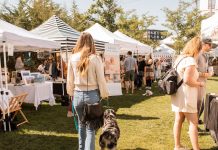 It may be cold and dreary outside, but that doesn’t mean your home and meals need to be, too. Believe it or not, winter is the perfect time to spruce up your kitchen and your family dinners with the color and flavors of an indoor herb garden.
It may be cold and dreary outside, but that doesn’t mean your home and meals need to be, too. Believe it or not, winter is the perfect time to spruce up your kitchen and your family dinners with the color and flavors of an indoor herb garden.
“Now is a really popular time when people look to do windowsill gardening,” says Karen Bachman, director of marketing and corporate communications for Bachman’s and a fifth-generation family member who works with her two cousins to run the business.
Not sure how to start your own herb garden? Here are some tips from Bachman herself.
Selecting Herbs
There are two ways to start an herb garden. You can buy seeds or pre-started herbs. (Of course, it will take longer to get usable herbs if you start with seeds, but we understand the pride you may feel by growing them entirely on your own.) The perk to buying pre-started herbs is you can start snipping leaves from the plant immediately and use them right away.
If you opt to purchase pre-started herbs, it’s important to choose a plant that is full, even shaped, has new growth, and does not have any wilting. This will give you the best probability of success and provide the best taste.
If you’re not sure which herbs are your best bet, Bachman has insight: “Really popular herbs right now are chives, oregano, rosemary, sage, basil, and cilantro.”
Planting Tips
Indoor herbs, like many living plants, need adequate drainage to keep the root system from getting soggy and killing the plant. The best option is to find a container that allows for such drainage. However, if you want a trendy herb garden grown in mason jars, you could add rocks or pebbles to the bottom of the jar before adding soil. This will allow the water to drain properly and keep your plant happy and healthy.
In addition, regular potting soil works great for this type of plant and is sold in small bags for projects like this. If you’d like to fertilize your herbs, it’s best to fertilize only once during the winter using a water-soluble or foam fertilizer. “It helps plants grow robust and full of flavor,” Bachman says. “But don’t overdo it because it could burn your plant.”
Ideal Environment
Indoor herbs grow best if placed in bright, yet indirect, sunlight. (Near a sunny kitchen window is a safe bet.) Herbs also like humidity, so it’s important to monitor your plant to ensure it has enough moisture to thrive without overwatering it. Bachman recommends watering once per week. “Do the finger test,” she says. “If it’s moist, not damp, you’re good for another couple of days, but don’t let it dry out thoroughly. They should have moist but not soggy soil.”
Grooming
Of course, the biggest reason you’re likely growing herbs is to cook with them, so it’s important to groom them regularly. You can pinch off leaves anywhere there’s new growth or in an area that looks too bushy. “If your herbs are growing faster than you can eat them, you can freeze your herbs in an ice cube tray with olive oil,” Bachman says.
Ultimately, your goal is to keep your herb from flowering. When an herb flowers, it changes the taste form savory to bitter. “Cilantro is [an herb] that flowers quite quickly, as does oregano,” she adds.
Replanting
Herbs can grow indoors year round as long as you continue to groom them. But if you’re interested in replanting your herbs outdoors when the temperature warms up, it’s important to pay attention to the weather. Your herbs are used to the controlled environment of your home, so if the new environment is unstable, they likely won’t survive. Before replanting your herbs outdoors, make sure the temperature isn’t projected to drop below freezing for the remainder of the warm season and double-check there’s not a lot of rain in the forecast. Typically, it’s safe to replant your herbs outdoors near the end of April or early May, Bachman says.
Learn From the Pros
Need some help getting started? Bachman’s is hosting Garden-Fresh Heart-Healthy eating, a free workshop about fresh herbs at its Lyndale location on Saturday, Feb. 1 at 10:30 a.m.





















